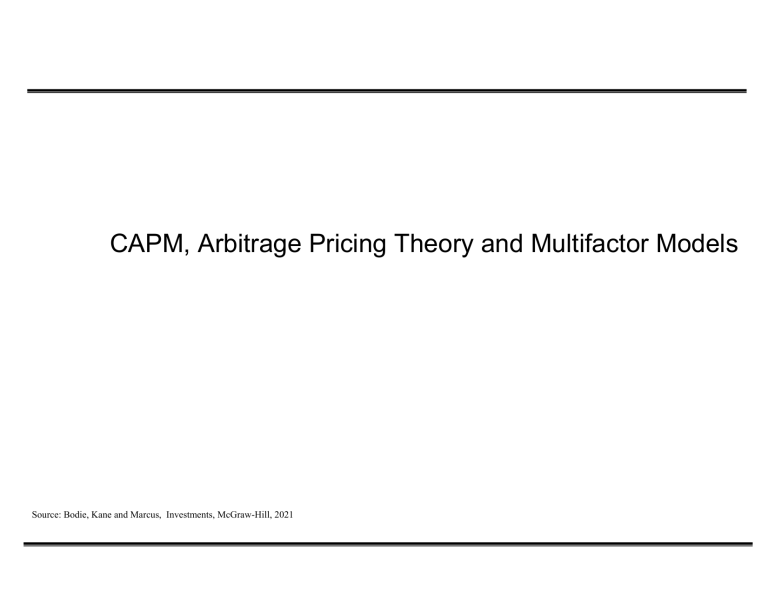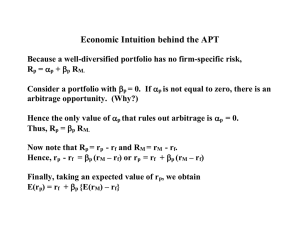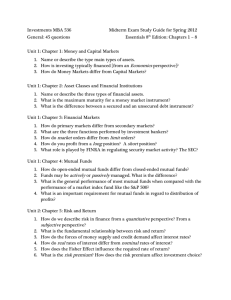
CAPM, Arbitrage Pricing Theory and Multifactor Models Source: Bodie, Kane and Marcus, Investments, McGraw-Hill, 2021 Capital Asset Pricing Model (CAPM) • • • • CAPM is a set of predictions concerning equilibrium expected returns on risky assets Based on two sets of assumptions • Individual behavior • Market structure Markowitz established modern portfolio management in 1952 Sharpe, Lintner and Mossin published CAPM in 1964 9-2 ©2018 McGraw-Hill Education Capital Asset Pricing Model (CAPM) • • • It is the equilibrium model that underlies all modern financial theory Derived using principles of diversification with simplified assumptions Markowitz, Sharpe, Lintner and Mossin are researchers credited with its development Assumptions: Resulting Equilibrium Conditions • All investors will hold the same portfolio for risky assets — market portfolio • Market portfolio contains all securities and the proportion of each security is its market value as a percentage of total market value The Efficient Frontier and the Capital Allocation Line The Efficient Frontier and the Capital Market Line Market Risk Premium • The risk premium on the market portfolio is proportional to its risk and the degree of risk aversion: Where E ( RM ) A A 2 M 2 M average degree of risk aversion across investors the variance of the market portfolio Return and Risk For Individual Securities • An individual security’s risk premium is a function of: • Its contribution to the risk of the market portfolio or the risk of investors’ overall portfolios: All investors use the same input list (i.e., they all end up using the market as their optimal risky portfolio) • The covariance of returns with the assets that make up the market portfolio Individual Securities: Example • Covariance of GE return with the market portfolio: n wi Cov( Ri , RGE ) Cov wi Ri , RGE i 1 i 1 n • The reward-to-risk ratio for GE would be: E ( RGE ) GE's contribution to risk premium GE's contribution to variance Cov( RGE , RM ) GE Example • Reward-to-risk ratio for investment in market portfolio: Market risk premium E ( RM ) 2 Market variance ( RM ) • These ratios should equal: E ( RGE ) E ( RM ) 2 Cov( RGe , RM ) ( RM ) GE Example The risk premium for GE: or: Restating, we obtain: Cov( RGe , RM ) E ( RGE ) E ( RM ) 2 ( RM ) E rGE rf GE E rM rf where beta i is the covariance of the return of asset i with the return of the market (M) divided by the variance of the return of the market over a certain period of time Risk premium is the product of a “benchmark risk premium” and the relative risk of the particular asset as measured by its beta Expected Return-Beta Relationship • CAPM holds for the overall portfolio because: E (rP ) wk E (rk ) and k P wk k k • This also holds for the market portfolio: E (rM ) rf M E (rM ) rf The Security Market Line The SML and a Positive-Alpha Stock Single-Index Model and Realized Returns • To move from expected to realized returns, use the index model in excess return form: Ri i i RM ei • The index model beta coefficient is the same as the beta of the CAPM expected return-beta relationship Single Factor Model • • Returns on a security come from two sources: • Common macro-economic factor • Firm specific events Possible common macro-economic factors • Gross Domestic Product growth • Interest rates Single Factor Model Ri E ( Ri ) i F ei Ri = Excess return on security βi= Factor sensitivity or factor loading or factor beta F = Surprise in macro‐economic factor (F could be positive or negative but has expected value of zero) ei = Firm specific events (zero expected value) Extensions of the CAPM 1. 2. 3. Identical Input Lists • In the absence of private information, investors should assume alpha values are zero Zero‐Beta Model • Helps to explain positive alphas on low beta stocks and negative alphas on high beta stocks Labor Income and Other Nontraded Assets • Many assets are not tradeable (e.g., private businesses, human capital, earning power of individuals, etc.) Extensions of the CAPM 4. Multiperiod Model and Hedge Portfolios • Investors should be more concerned with the stream of consumption that wealth can buy for them 5. Consumption‐Based CAPM (CCAPM) • Rubinstein, Lucas, and Breeden • Investors allocate wealth between consumption today and investment for the future 6. Liquidity • Financial costs inhibit trades • Liquidity of an asset is the ease and speed with which it can be sold at fair market value • Illiquidity can be measured in part by the discount from fair market value a seller must accept if the asset is to be sold quickly The Relationship Between Illiquidity and Average Returns 9-20 ©2021 McGraw-Hill Education Liquidity Risk • • • In a financial crisis, liquidity can unexpectedly dry up When liquidity in one stock decreases, it commonly tends to decrease in other stocks at the same time Investors demand compensation for liquidity risk, demonstrated by firms with greater liquidity risk having higher average returns • “Liquidity betas” 9-21 ©2018 McGraw-Hill Education The CAPM and Academia and Inudstry • Testing the CAPM is surprisingly difficult • Cannot observe all tradable assets – Impossible to pin down market portfolio • Both alpha and beta, as well as residual variance, are likely time varying • Most tests of the CAPM are directed at the mean-beta relationship as applied to assets with respect to an observed, but perhaps inefficient, stock index portfolio • Portfolio theory and the CAPM have become accepted tools in the practitioner community • Many professionals are comfortable with the use of beta to measure systematic risk • Most investors don’t beat the index portfolio 9-22 ©2018 McGraw-Hill Education Multifactor Models: Overview • • Arbitrage is the exploitation of security mispricing in such a way that risk-free profits can be earned • Most basic principle of capital market theory is that well-functioning security markets rule out arbitrage opportunities Generalization of the security market line of the CAPM to gain richer insight into the risk-return relationship • Arbitrage pricing theory (APT) ©2018 McGraw-Hill Education Multifactor Models • Extra market sources of risk may arise from several sources • E.g., uncertainty about interest rates or inflation. • Use more than one factor: Market Return, GDP, Expected Inflation, Interest Rates • Multifactor models posit that returns respond to several systematic risk factors, as well as firm-specific influences • Useful in risk management applications • Estimate a beta or factor loading for each factor using multiple regression Multifactor Model Equation Ri E Ri iGDP GDP iIR IR ei Ri = Excess return for security i E(Ri ) = Expected excess return for security i βGDP = Factor sensitivity for GDP βIR = Factor sensitivity for Interest Rate ei = Firm specific events In this example, the return on a security is the sum of: 1. Its expected return 2. The sensitivity to GDP times the GDP risk premium 3. The sensitivity to interest rate risk times the interest rate risk premium If the macro factors are expected to be 0 then Ri = E(Ri ) Arbitrage Pricing Theory • Arbitrage pricing theory (APT) was developed by Stephen Ross • Predicts a SML linking expected returns to risk, but the path is takes to the SML is quite different • APT relies on three key propositions: 1. Security returns can be described by a factor model 2. There are sufficient securities to diversify away idiosyncratic risk 3. Well-functioning security markets do not allow for the persistence of arbitrage opportunities • Arbitrage occurs if there is a zero investment portfolio with a sure profit: E.g., shares of a stock sell for different prices on two different exchanges • No investment investors create large positions to obtain large profits • All investors will want an infinite position in the risk-free arbitrage portfolio • In efficient markets, profitable arbitrage opportunities will quickly disappear Law of One Price • The Law of One Price: if two assets are equivalent in all economically relevant respects, then they should have the same market price • Enforced by arbitrageurs: If they observe a violation they will engage in arbitrage activity • This bids up (down) the price where it is low (high) until the arbitrage opportunity is eliminated Well-Diversified Portfolios • In a well‐diversified portfolio, firm‐specific risk becomes negligible, so that only factor risk remains • One effect of diversification is that, when n is large, nonsystematic variance approaches zero • A well‐diversified portfolio is on with each weight small enough that for practices purposes the nonsystematic variance is negligible APT and Well-Diversified Portfolios RP E ( RP ) P F eP where F Systematic Risk E ( RP ) wi E ( Ri ) P wi i eP wi ei • In a well‐diversified portfolio, firm‐specific risk becomes negligible, so that only factor risk remains • when n is large, nonsystematic variance approaches zero: eP 0 • and their associated weights are small enough that for practices purposes the nonsystematic variance is negligible Returns as a Function of the Systematic Factor Returns as a Function of the Systematic Factor: An Arbitrage Opportunity An Arbitrage Opportunity The SML of the APT: No-Arbitrage Equation • • All well-diversified portfolio with the same beta must have the same expected return Generally, for any well-diversified P, the expected excess return must be: E ( RP ) P E ( RM ) • Risk premium on portfolio P is the product of its beta and the risk premium of the market index • SML of the CAPM must also apply to well-diversified portfolios 10-33 ©2018 McGraw-Hill Education APT and CAPM APT CAPM • Assumes a well‐diversified portfolio, but residual risk is still a factor • Does not assume investors are mean‐ variance optimizers • Uses an observable market index • Reveals arbitrage opportunities • Model is based on an inherently unobservable “market” portfolio • Rests on mean‐variance efficiency. The actions of many small investors restore CAPM equilibrium Multifactor APT • • • Use of more than a single systematic factor Requires formation of factor portfolios What factors? • Factors that are important to performance of the general economy • What about firm characteristics? 10-35 Two-Factor Model • Multifactor APT: APT can be generalized to accommodate these multiple sources of risk Ri E ( Ri ) i1 F1 i 2 F2 ei • Benchmark portfolios in the APT are factor portfolios • β=1 for one of the factors and β= 0 for any other factors • Factor portfolios track a particular source of macroeconomic risk, but are uncorrelated with other sources of risk – Referred to as a “tracking portfolio” Fama-French Three-Factor Model Rit i iM RMt iSMB SMBt iHML HMLt eit • • • • • SMB = Small minus big (i.e., the return of a portfolio of small stocks in excess of the return on a portfolio of large stocks) (firm size premium) HML = High minus low (i..e, the return of a portfolio of stocks with a high book-tomarket ratio (value stocks) in excess of the return on a portfolio of stocks with a low book-to-market ratio (growth stocks)) (value premium) Are these firm characteristics correlated with actual systematic risk factors? A multi-index CAPM inherits its risk factors from sources that a broad group of investors deem important enough to hedge The APT is largely silent on where to look for priced sources of risk



